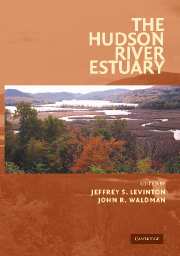Book contents
- Frontmatter
- Contents
- Preface
- List of Contributors
- The Hudson River Estuary
- 1 The Hudson River Estuary: Executive Summary
- GEOLOGICAL, PHYSICAL, AND CHEMICAL SETTING OF THE HUDSON
- PRIMARY PRODUCTION, MICROBIAL DYNAMICS, AND NUTRIENT DYNAMICS OF THE HUDSON
- HUDSON RIVER COMMUNITIES, FOOD WEBS, AND FISHERIES
- 12 Larval Migrations Between the Hudson River Estuary and New York Bight
- 13 The Diadromous Fish Fauna of the Hudson River: Life Histories, Conservation Concerns, and Research Avenues
- 14 Fisheries of the Hudson River Estuary
- 15 The Role of Tributaries in the Biology of Hudson River Fishes
- 16 Ecology of the Hudson River Zooplankton Community
- 17 Submersed Macrophyte Distribution and Function in the Tidal Freshwater Hudson River
- 18 Long-Term and Large-Scale Patterns in the Benthic Communities of New York Harbor
- 19 The Benthic Animal Communities of the Tidal-Freshwater Hudson River Estuary
- 20 Tidal Wetlands of the Hudson River Estuary
- 21 Alien Species in the Hudson River
- CONTAMINANTS AND MANAGEMENT ISSUES OF THE HUDSON RIVER ESTUARY
- Index
- Plate section
- References
14 - Fisheries of the Hudson River Estuary
Published online by Cambridge University Press: 06 January 2010
- Frontmatter
- Contents
- Preface
- List of Contributors
- The Hudson River Estuary
- 1 The Hudson River Estuary: Executive Summary
- GEOLOGICAL, PHYSICAL, AND CHEMICAL SETTING OF THE HUDSON
- PRIMARY PRODUCTION, MICROBIAL DYNAMICS, AND NUTRIENT DYNAMICS OF THE HUDSON
- HUDSON RIVER COMMUNITIES, FOOD WEBS, AND FISHERIES
- 12 Larval Migrations Between the Hudson River Estuary and New York Bight
- 13 The Diadromous Fish Fauna of the Hudson River: Life Histories, Conservation Concerns, and Research Avenues
- 14 Fisheries of the Hudson River Estuary
- 15 The Role of Tributaries in the Biology of Hudson River Fishes
- 16 Ecology of the Hudson River Zooplankton Community
- 17 Submersed Macrophyte Distribution and Function in the Tidal Freshwater Hudson River
- 18 Long-Term and Large-Scale Patterns in the Benthic Communities of New York Harbor
- 19 The Benthic Animal Communities of the Tidal-Freshwater Hudson River Estuary
- 20 Tidal Wetlands of the Hudson River Estuary
- 21 Alien Species in the Hudson River
- CONTAMINANTS AND MANAGEMENT ISSUES OF THE HUDSON RIVER ESTUARY
- Index
- Plate section
- References
Summary
abstract Fisheries have been prosecuted in the Hudson since prehistoric times. Oysters, American shad, and sturgeon were important food fisheries into the twentieth century, although of these, only a dwindling commercial shad fishery persists. Striped bass, another formerly important commercial fishery, went into decline and subsequent recovery from management actions; today, it supports a major recreational fishery. Other important sport fishing includes largemouth and smallmouth bass, and American shad. Toxicants and power plants have been long-term threats to fisheries, and will continue to pose problems for the indefinite future.
Introduction
Of all the relationships humankind entertains with the Hudson River, perhaps none is so intimate as that of fishing. The harvest of fish and shellfish from the Hudson has endured for thousands of years, and connects us both with the river's productivity and with our cultural past.
Other chapters in this book describe the fish fauna and its use of various habitats within the system. Here, we concentrate on the fisheries themselves, focusing on key species within the commercial and sportfishing arenas. We also examine some of the factors that potentially have large effects on fisheries, namely, the impacts of power plants that withdraw water from the river, and the persistence of contaminants, especially PCBs.
Historical Importance of Hudson River Fisheries
FROM NATIVE TO COMMERCIAL FISHING
Before modern agriculture and globalization of products, the fisheries of the Hudson River were an important and diverse local source of protein.
- Type
- Chapter
- Information
- The Hudson River Estuary , pp. 189 - 204Publisher: Cambridge University PressPrint publication year: 2006
References
- 5
- Cited by



